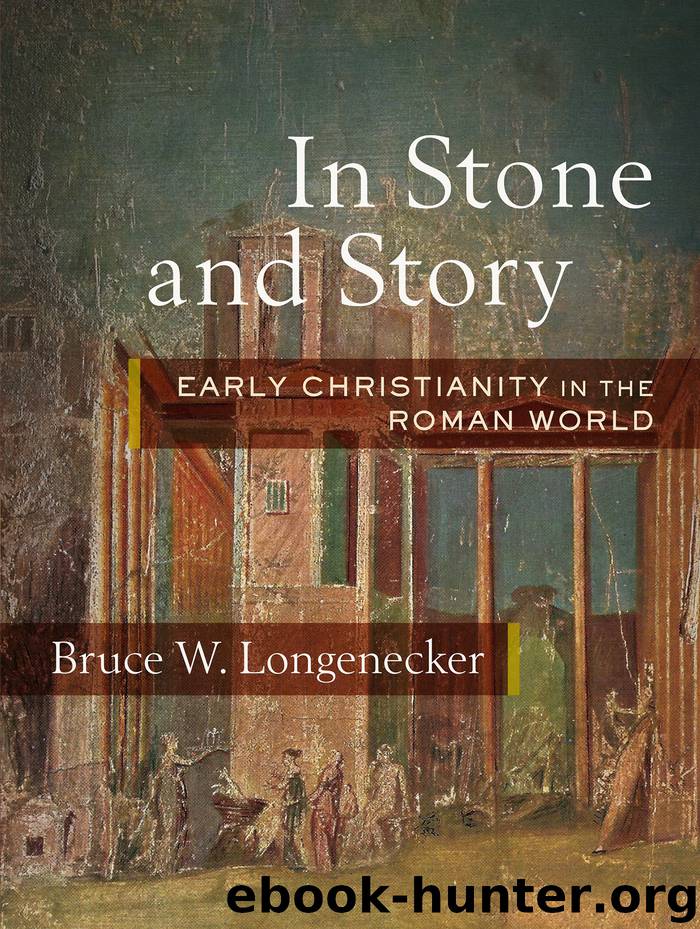In Stone and Story by Bruce W. Longenecker

Author:Bruce W. Longenecker
Language: eng
Format: epub
Tags: New Testament/Early Christianity;Church history—Primitive and early church (ca. 30–600);Pompeii (Extinct city)—Church history;Pompeii (Extinct city)—Civilization;REL006630;REL006220;REL072000
Publisher: Baker Publishing Group
Published: 2019-12-01T16:00:00+00:00
13
Combat and Courts
As for us [apostles], why do we endanger ourselves every hour? I face death every day. . . . If I fought wild beasts in Ephesus with no more than human hopes, what have I gained?
1 Corinthians 15:30–32 NIV
Spectacles of Combat
Fighting wild beasts were regular displays in many urban centers of the Roman age. In amphitheaters like the one in Pompeii, arena fights were spectacles that urban populations seem to have eagerly anticipated and regularly consumed. Fights between groups of wild beasts, between gladiators, and between gladiators and wild beasts were exhilarating high points in the civic life of an urban center. In the coming together of all strands of society, people could enjoy viewing competition, combat, danger, and occasionally the death of other human beings. Some gladiators became superstars among the local population. Pompeii’s spectacula (as the amphitheater was called) provided enough seating for twenty thousand people—almost twice as much as the population of the town itself. Judging by the Pompeian announcements of games in other nearby urban centers (like Cumae, Nola, Nuceria, and Puteoli), people must have come to Pompeii from far and wide within the region to watch these spectacles of wonder. To ensure the best quality of competition within their town, the magistrates of Pompeii converted what had once been a large public portico in the “theater district” into a barracks and training ground for many gladiators (see figure 13.1).
Gladiators were usually slaves, their masters owning a gladiatorial troupe. The gladiators would have lived together in the barracks, trained together in the courtyard of the barracks, and then been forced to compete against each other (and against members of other gladiatorial troupes) in the amphitheater. Many of Pompeii’s gladiators resided in the very small rooms dotted around the courtyard of the barracks. When the rooms were excavated in the eighteenth century, some skeletons were found in some of the rooms, some skeletons having iron chains and fetters on their legs and arms—indicating that these gladiators had been restrained throughout the eruption of Vesuvius, with no one coming to release them.
Download
This site does not store any files on its server. We only index and link to content provided by other sites. Please contact the content providers to delete copyright contents if any and email us, we'll remove relevant links or contents immediately.
The Apogee - Byzantium 02 by John Julius Norwich(1422)
The Mysteries of Mithra by Cumont Franz(1340)
A Short History of England by Simon Jenkins(1308)
The Case for God by Karen Armstrong(1222)
The Tragedy of the Templars by Michael Haag(1216)
Sacred Britannia: The Gods and Rituals of Roman Britain by Aldhouse-Green Miranda(1141)
All the Pope's Men by John L. Allen Jr(1057)
Raising Hell: A Concise History of the Black Arts and Those Who Dared to Practice Them by Robert Masello(957)
The Physics Book by DK(957)
Christian by Sean Michael(940)
War by Unknown(932)
The Evolution of God by Robert Wright(871)
Life Stories by unknow(868)
Living With the Gods: On Beliefs and Peoples by Neil MacGregor(845)
Early Daoist Dietary Practices by Shawn Arthur(815)
Football School Season 2 by Alex Bellos(815)
Great Transformation by Karen Armstrong(807)
A Cup of Trembling by Dave Hunt(800)
Making Haste From Babylon(794)
